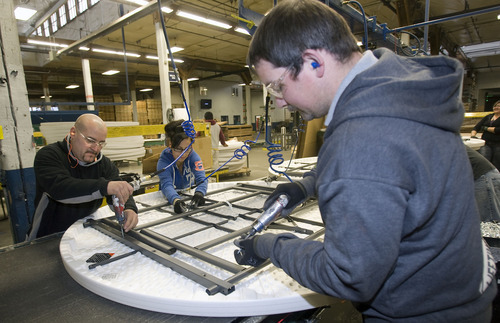This is an archived article that was published on sltrib.com in 2012, and information in the article may be outdated. It is provided only for personal research purposes and may not be reprinted.
The three metros along Utah's Wasatch Front suffered a milder downturn and are farther along in their recovery from the Great Recession than all other big urban areas in the Mountain West, according to a Brookings Institution report released Wednesday.
Recoveries in Salt Lake City, Provo-Orem and Ogden are "at the top of the 10" metros in the region, said Robert Lang, director of Brookings Mountain West, a joint project of the Washington-based think tank and the University of Nevada at Las Vegas.
"In terms of the whole history of the recession," Lang said of its impact, "[the three metros also] are the top of the 10."
A recovery was firmly under way during the fourth quarter of 2011 inside a large strip of the West that also includes Denver, Colorado Springs, Albuquerque, Tucson, Phoenix, Las Vegas and Boise. But the pace varied widely among the 10 metros, according to the report.
Six saw growth in the October-through-December period, but only four saw the pace of growth accelerate over the third quarter. Output — the value of goods and services — grew everywhere, but only in half of the region's metros did the pace of growth speed up, the report said.
Unemployment rates were down in all 10 metros, compared with the same quarter of 2010. Housing prices in most markets stabilized. Even so, signs of a sustained recovery "remained elusive" during the last quarter of 2011, according to the report.
Except along the Wasatch Front, where Utah's three metros "have successfully proceeded into solid recovery," the report said.
"Given that, [Salt Lake City, Provo-Orem and Ogden] are closer to achieving a full recovery — a return to pre-recession employment and output levels, unemployment rates and housing prices — than any of their peers in the region, which have farther to climb back," the report said.
The recovery in Utah hasn't been without setbacks. During the fourth quarter, employment in Ogden contracted a "surprising" 1.2 percent after growth exceeding 1 percent in each of the previous two quarters. Provo-Orem's job growth also turned negative, with job numbers falling by 0.3 percent from the third quarter.
On the other hand, Salt Lake City led the region. Job numbers were up 0.8 percent in the fourth quarter, compared with three months earlier. Utah's capital was the only metro in the region to rank in the top 20 of the 100 biggest metros in the U.S. in employment growth.
And despite recent job losses in Provo and Orem, the two-city metro was one of the top 20 U.S. metros in overall performers during the quarter, in part because of an upturn in the information technology industry. Salt Lake City was in the top 40 for the same reason, along with Boston and Minneapolis.
"The [Wasatch Front] has invested in higher education and that's paid dividends" by giving rise to technology startups, Lang said.
Output of goods and services grew strongly in Utah in the fourth quarter, with rates of 1.3 percent to 1.4 percent, putting the three metros "firmly in the top 20 percent of metros nationally," according to the report. Lang said the increases are based on the diversity of the state's economy, which he said has more variety than much of the rest of the country and is increasingly based on exports.
"That is creating better demand for Utah products," Lang said.
Home prices in Utah's metros rose in the waning months of last year. Increases in Salt Lake City and Provo-Orem were 1 percent and 0.7 percent, respectively. The U.S. increase was 0.7 percent.
Twitter: @sltribpaul —
Salt Lake City, Provo-Orem and Ogden turn backs on recession
Employment • Salt Lake City is up 3.1 percent since a trough in the third quarter 2009 versus the U.S., up 1.6 percent; Provo-Orem is up 4.3 percent since a trough in the fourth quarter 2009; Ogden is up 3.1 percent since a trough in first quarter 2010.
Housing prices • Salt Lake City is up 2.2 percent since a trough in second quarter 2011 versus the U.S., up 1.4 percent; Provo-Orem is up 1.8 percent since a trough in second quarter 2011; Ogden is up 2.5 percent since a trough in second quarter 2011.



